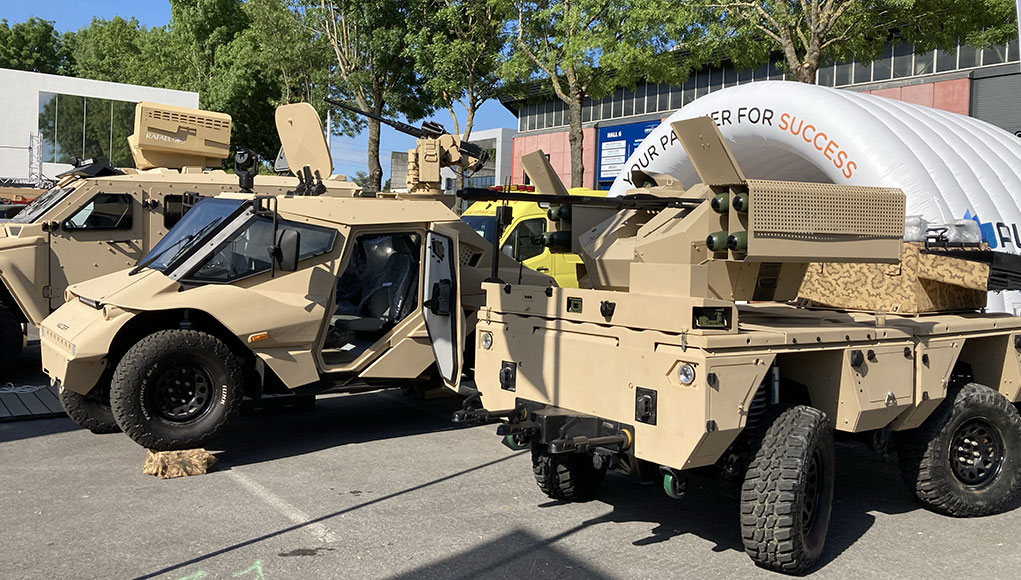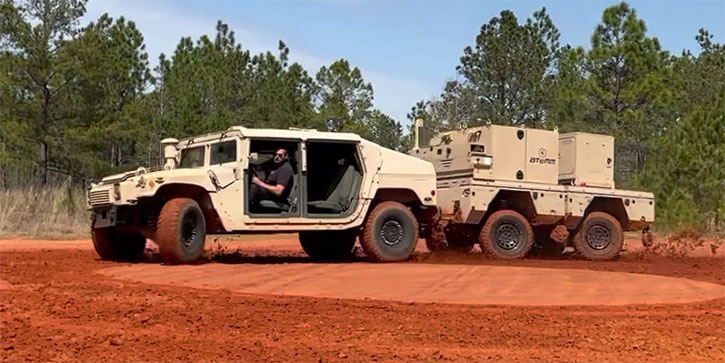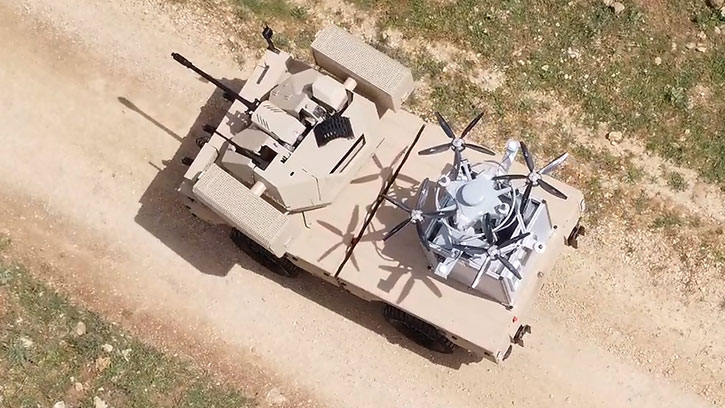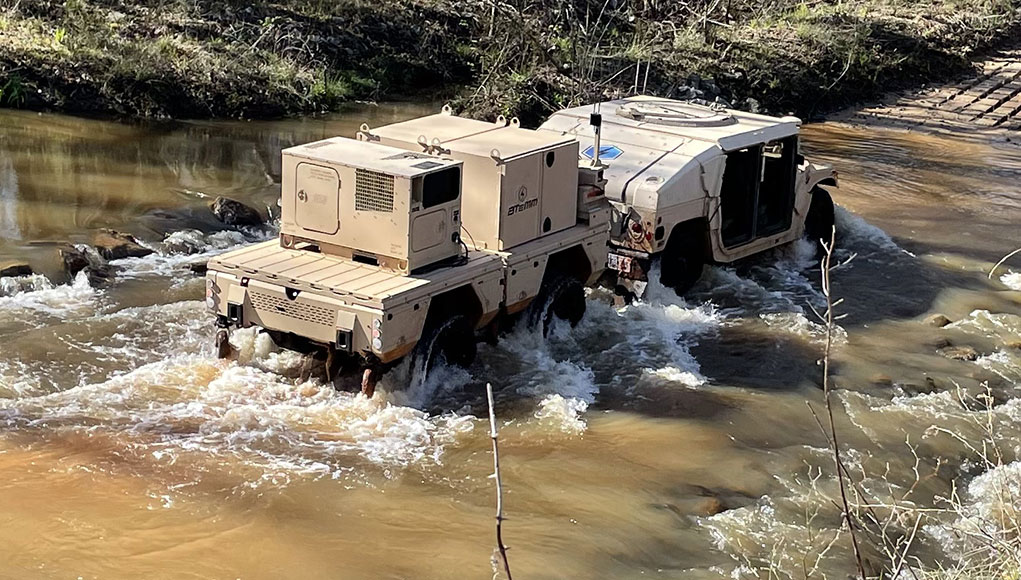Agility, resilience, and self-sufficiency are basic for military forces operating in the field and engaged in warfighting far from their permanent bases. But operating in these conditions poses significant challenges with ever-growing energy consumption, increasing weight, and dependence on complex systems that require experienced operators and logistical tail for supply and support.
A new platform developed by Plasan may provide a solution for some of those needs. At Eurosatory 2022 Plasan showcases the All-Terrain Electric Mission Module (ATeMM), which provides an array of services to enhance the autonomy of tactical units, particularly in load carrying, electrical supply, and robotics operations. In fact, ATeMM is positioned to provide a mobility and autonomy ‘multitool’ that comes in handy in numerous use cases.
Although it looks like a trailer, ATeMM represents a new category in mobility – different from anything we are familiar with today. To understand its potential, let’s look inside. The system combines a load-carrying flatbed, an automotive system, and an electrical energy storage pack. The automotive system uses a single axle, two wheels with independent suspensions, brakes, a differential, and electro-hydraulic steering. The axle is coupled to a 190 HP electric motor/generator. The system can move the wheels or generate electricity in motion, to charge the battery that stores 35kWh of electrical energy. All systems are operated automatically and controlled through an operating system on board.

Unlike other trailers, when ATeMM is connected to a standard 2×4 or 4×4 vehicle, it turns that vehicle into a hybrid-electric 6×6. When two ATeMMs are coupled together, they turn that vehicle into an 8×8. Two, three, or four ATeMMs can also operate autonomously as Unmanned Ground Vehicles (UGV). This is only part of the versatility the ATeMM is capable of.
Power Max – Converting a 4×4 to 6×6
Users can select three operating modes. In the economy mode, ATeMM conserves energy through regenerative motion, with electricity generated and stored when the vehicle decelerates, as in other hybrid electric vehicles, when the driver press the accelerator pedal, ATeMM adds electrical power to support the vehicle. In charge mode, ATeMM is charged by the vehicle motion. While fuel consumption grows, the efficiency of generated electrical power is much higher than on-board generators.

The third Power Max mode delivers maximum power to boost the momentum of the host vehicle, as the trailer pushes the vehicle. This mode enables a standard 4×4 to achieve much improved offroad mobility and obstacle crossing. This capability also enables vehicles to achieve stealth by eliminating engine noise and maintaining a silent watch for many hours without draining the vehicle’s battery.
The patented twist-lock three-point fast connector system enables the trailer to become an integral part of the vehicle, allowing the driver full maneuverability in forward or reverse tight turns, and high-speed steering. The 1,950 mm wide trailer is air-transportable in helicopters and tactical transport aircraft, its height can be adjusted to adapt to different vehicles. Plasan also considers a smaller 1,650 mm wide version to match All-Terrain Vehicles (ATV) that will be air-transportable in the V-22 tilt-rotor aircraft.

An abundance of Energy
The military needs large amounts of energy to sustain forces in the field. Communications, displays, computers, electro-optics, electronic warfare, missile launchers, drones, and other electronic devices require a constant flow of electricity in the form of fuel, generator sets, or batteries, to be pushed to deployed units. To keep their momentum, they need lots of energy in a form that is readily usable for battery charging or powering other systems.
ATeMM is equipped with multiple options to generate and provides electrical energy. When in motion, it regenerates up to 26 kW of electricity. ATeMM regenerates up to 60 percent of the energy consumed by the vehicle during traveling, energies that were mostly dissipated as heat and other forms of energy loses. When towed behind a host vehicle it generates 15 kW when braking and through coast regeneration). With this regenerative braking and coast regeneration, the ATeMM arrives at its destination fully charged, despite powering devices while in transport. It also has flexible output options supporting 24VDC, 110/220 AC, etc. To store the energy on board ATeMM uses lithium LiFePo T6 batteries offering standard efficiency at a high level of safety, for maximum storage capacity a new lithium-ion system is used, where each segment is immersed in liquid to prevent battery runoff in case of battery damage. Utilizing a smart energy management system managing the onboard battery bank, and regenerative energy produced when the vehicle is in motion, ATeMM provides the user with an efficient Off-Board power source. For example, this energy supply exceeds the needs of a forward command post that is often powered by tactical generator sets. To ensure continuity, two generators are constantly running, therefore doubling the fuel consumption. Using a single ATeMM, the vehicle engine can be used for backup power.
 ATeMM-T – the Modular UGV
ATeMM-T – the Modular UGV
Another aspect of ATeMM versatility is coupling two units into unmanned vehicles (ATeMM-T). Unlike other UGVs that require charging, transportation, disembarking, and set up by robotics specialists, at the point of deployment, ATeMMs are simply towed by the vehicles and deployed by the troops to begin their mission. Up to four ATeMMs can be connected to form an 8×8 robot that can carry weapon stations, missile launchers, sensors on a telescopic mast, Counter-AUS systems, and more, with a fully electric drive providing power equivalent to 800 HP. When not used as a robotic platform each unit can be decoupled and serve as a power supply, delivering up to 100 kW/h to support other systems.
 As a tandem, ATeMM-T can be detached from the host vehicle and operate via remote control, enabling unmanned travel with low signature (heat, noise). ATeMM-T can carry twice the payload of the ATeMM (2.3 tons), storing an increased energy reserve of up to 70 kWh. Another advantage of the system is its ability to deploy with its payload as an autonomous unit, thus avoiding complex and expensive modifications to the host vehicle.
As a tandem, ATeMM-T can be detached from the host vehicle and operate via remote control, enabling unmanned travel with low signature (heat, noise). ATeMM-T can carry twice the payload of the ATeMM (2.3 tons), storing an increased energy reserve of up to 70 kWh. Another advantage of the system is its ability to deploy with its payload as an autonomous unit, thus avoiding complex and expensive modifications to the host vehicle.
ATeMM is as far from your grandfather’s trailer as a smartphone differs from the 1950s telephone. It provides many services for mobility, energy supply, or system integration on vehicles, but its most important contribution is adding flexibility, agility, and resilience to military forces in the field, where they can improvise and use it on their missions as a useful multitool.




















